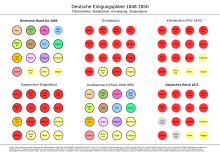Small German solution
The small German solution to the German question was one of two solutions discussed during the revolutionary period of 1848/49 and after. The other was called the Greater German solution . After the Little German solution was implemented in 1867–1871, the name lost its meaning: Since then, Germany has been essentially equated with this Little Germany. The other term, large German, was used to include Austria .
Revolutionary period 1848/49
The German Confederation of 1815 was the basis for the discussions in the Frankfurt National Assembly in 1848/1849 for the emerging German Empire . Most of the MPs took it for granted that the federal territory should become the Reich territory. In some cases it was supposed to go beyond that, namely also to include the provinces in eastern Prussia, which the Federation had already accepted before the National Assembly met. There was also Schleswig , which as a Danish fief did not belong to the federal government, but was inseparably linked to the federal member Holstein in the conception of the German national movement.
In October 1848, at the latest in March 1849, it became abundantly clear that the Austrian Empire could not become part of the Empire. The Austrian government refused to allow only part of the entire Austrian state to join. An important preliminary decision was the overthrow of the Schmerling cabinet in December 1848 : the chairman of the all-German Council of Ministers, Anton von Schmerling , was Austrian and has now been replaced by Heinrich von Gagern from Hesse .
The new Reich Minister President Gagern advocated a double alliance : Germany without Austria should become a federal state. This closer federation was later called Kleindeutschland , which concerned the geographic extent. Small Germany should then be linked to all of Austria in a further federation , a confederation of states.
The question of Großdeutsch / Kleindeutsch divided the National Assembly and the German public. The more hostile Austria behaved, the more support the small German solution gained, as it is then recognizable in the Frankfurt Imperial Constitution . In theory, the constitution kept open the accession of the Austrian territories that had previously belonged to the German Confederation, i.e. the Greater German solution.
Erfurt Union and German Empire
In 1849/50 Prussia tried to realize small Germany as the Erfurt Union . This federal state should include all German areas except Austria, but be more conservative and federalist than the realm of the Frankfurt National Assembly. However, Prussia did not succeed in winning Bavaria and Württemberg for this policy right from the start, and later, with Hanover and Saxony, other medium-sized states dropped out. After the autumn crisis of 1850 , in which it almost came to war between Prussia or the Union and above all Austria and Bavaria, Prussia had to give up union policy.
In its federal reform plan of June 10, 1866 , Prussia presented a Prussian-Bavarian-led small Germany. After the victory over Austria in the German War, Prussia was able to partially realize its ideas with the North German Confederation of 1867. However, the remaining southern German states did not join this nation state until 1870/71; this is how the German Empire (1871–1918) came into being.
Since Austria and Liechtenstein did not belong, the empire was the realization of small Germany. In contrast to 1848–1850, however, Luxembourg and Limburg were absent ; In addition to Schleswig, the empire also included Alsace-Lorraine , which had been conquered in the war against France.
After the First and Second World Wars
Between the world wars of the 20th century, the question of “small German or large German solution” was raised again. After the dissolution of the multi-ethnic state Austria-Hungary at the end of the First World War , a new political map was created. The non-German areas made themselves independent, while the politicians and the population of German Austria wanted to join the German republic . This would have roughly corresponded to the Greater German solution of 1848, but without the part of Bohemia, which is predominantly inhabited by Czechs. This merger was expressly forbidden in the Paris suburban treaties ( Treaty of Saint-Germain , Treaty of Versailles ).
In 1938, the ruler of the German Reich, Adolf Hitler , forced his home country Austria (called reunification) to join the National Socialist German Reich , which from then on (officially 1943) was referred to as the Greater German Reich . After the defeat in World War II , this empire broke apart again, and Austria as an independent state was restored at the instigation of the allied victorious powers.
The post-war Germany was, as well as the post-war Austria until 1955, in occupied zones divided. In the west, with the exception of Saarland, which was politically separated in 1946 and autonomously administered from 1947 to the end of 1956 , the old state borders were re-established ( East Belgium and Alsace-Lorraine). The German states emerged on the western territories of the Reich and only in 1949 the Federal Republic of Germany . The German Democratic Republic was founded in the center of Germany. The eastern territories of the German Empire came under the administration of the People's Republic of Poland and the Soviet Union , were depopulated of their inhabitants with the exception of small remnants and since then have been populated with Poles and Russians . With the accession of the GDR to the Federal Republic ( German unification in 1990 ) and the official recognition of the Oder-Neisse border (Polish shift to the west), the territory of today's Federal Republic of Germany no longer corresponds by a long way to the earlier small German solution.



